State-of-the-Art in the Use of Renewable Energy Sources on the Example of Wind, Wave Energy, Tidal Energy, and Energy Harvesting: A Review from 2015 to 2024
Abstract
1. Introduction
2. Materials and Methods
2.1. The Categories Used in This Study
2.2. State-of-the-Art: A Review from 2015 to 2024
2.3. Technical Discussion and Critical Analysis
3. Results
4. Unsolved Problems
- Integration of Multiple Renewable Energy Systems: The trend toward integrating various renewable energy systems, such as wind–wave hybrid systems, is expected to continue. This integration aims to maximize energy generation while minimizing platform movements, thereby enhancing overall efficiency and reliability [117].
- Advanced Control Strategies: It is essential to develop advanced control strategies for offshore wind turbines and wave energy converters. Techniques such as aerodynamic thrust optimization and torque compensation control are being studied to improve stability and efficiency [118]. However, real-world implementation of these strategies will require further research and validation.
- Modular and Scalable Solutions: Modular solutions and the use of triboelectric nanogenerators for low-frequency wave energy harvesting are gaining popularity. These innovations offer promising avenues for improving the efficiency and reliability of renewable energy systems [117]. The scalability and long-term performance of these technologies will be critical to large-scale deployment.
- Energy Storage Systems: The relatively low number of publications on energy storage systems highlights a critical gap in the research. Efficient energy storage solutions are essential to complement renewable energy generation and ensure a stable energy supply [119]. Future research will likely focus on developing and optimizing these systems.
- Policy and Market Dynamics: Government policies and market dynamics will continue to play a crucial role in the advancement of renewable energy technologies. Subsidies, incentives, and regulatory frameworks will drive innovation and investment in this sector [119]. Additionally, the growing demand for clean energy will push the industry towards more sustainable and efficient solutions.
- Technological Innovations: Emerging technologies, such as artificial intelligence, blockchain, and advanced materials, will revolutionize the renewable energy sector. These innovations will enhance the efficiency, reliability, and integration of renewable energy systems [120].
- Global Collaboration and Investment: International collaboration and investment will be crucial for the advancement of renewable energy technologies. Countries with significant renewable energy potential, such as China and the United States, are expected to lead the way in research, development, and deployment [121].
5. Conclusions
- The location of systems in seas poses logistical and operational challenges. Implementing innovative technologies requires significant investment and cooperation.
- Recent years have seen numerous studies on offshore wind turbines, wave energy, and energy harvesting, indicating their application potential. Tidal energy and energy storage systems, despite their potential, are less frequently researched.
- Renewable energy in seas and oceans offers a minimal carbon footprint but raises concerns about ecosystem impact. Integrating different energy sources can create hybrid power parks that withstand extreme conditions, enhancing energy supply stability.
Author Contributions
Funding
Institutional Review Board Statement
Informed Consent Statement
Data Availability Statement
Conflicts of Interest
References
- Mazzucato, M.; Semieniuk, G. Financing Renewable Energy: Who Is Financing What and Why It Matters. Technol. Forecast. Soc. Change 2018, 127, 8–22. [Google Scholar] [CrossRef]
- Johnstone, N.; Haščič, I.; Popp, D. Renewable Energy Policies and Technological Innovation: Evidence Based on Patent Counts. Environ. Resour. Econ. 2010, 45, 133–155. [Google Scholar] [CrossRef]
- Carley, S. State renewable energy electricity policies: An empirical evaluation of effectiveness. Energy Policy 2009, 37, 3071–3081. [Google Scholar] [CrossRef]
- Marques, A.C.; Fuinhas, J.A. Are public policies towards renewables successful? Evidence from European countries. Renew. Energy 2012, 44, 109–118. [Google Scholar] [CrossRef]
- Przychodzen, W.; Przychodzen, J. Determinants of renewable energy production in transition economies: A panel data approach. Energy 2020, 191, 116583. [Google Scholar] [CrossRef]
- Sugumar, B.K.; Anglani, N. A Novel Decision-Support Framework for Supporting Renewable Energy Technology Siting in the Early Design Stage of Microgrids: Considering Geographical Conditions and Focusing on Resilience and SDGs. Energies 2025, 18, 544. [Google Scholar] [CrossRef]
- Cao, F.; Yu, M.; Liu, B.; Wei, Z.; Xue, L.; Han, M.; Shi, H. Progress of Combined Wind and Wave Energy Harvesting Devices and Related Coupling Simulation Techniques. J. Mar. Sci. Eng. 2023, 11, 212. [Google Scholar] [CrossRef]
- Gao, Q.; Jiang, C.; Yang, Y.; Ritschel, U. Comparative Study of Numerical Methods for Predicting Wave-Induced Motions and Loads on a Semisubmersible. J. Mar. Sci. Appl. 2023, 22, 499–512. [Google Scholar] [CrossRef]
- Zhang, F.; Zhu, W.; Zu, S.; Zhang, X.; Chen, J.; Wu, B.; Huang, J. Control Research on Active Pitch Control System for Horizontal-Axis Tidal-Current Turbine Generator. Energies 2025, 18, 764. [Google Scholar] [CrossRef]
- López, M.; Rodríguez, N.; Iglesias, G. Combined Floating Offshore Wind and Solar PV. J. Mar. Sci. Eng. 2020, 8, 576. [Google Scholar] [CrossRef]
- Jo, C.; Kim, D.; Hwang, S.; Goo, C. Shape Design of the Duct for Tidal Converters Using Both Numerical and Experimental Approaches (Pre-2015). Energies 2016, 9, 185. [Google Scholar] [CrossRef]
- Li, L.; Gao, Y.; Yuan, Z.; Day, S.; Hu, Z. Dynamic Response and Power Production of a Floating Integrated Wind, Wave and Tidal Energy System. Renew. Energy 2018, 116, 412–422. [Google Scholar] [CrossRef]
- Onea, F.; Rusu, L. Coastal Impact of a Hybrid Marine Farm Operating Close to the Sardinia Island. In Proceedings of the OCEANS 2015—Genova, Genova, Italy, 18–21 May 2015; pp. 1–7. [Google Scholar] [CrossRef]
- Sousounis, M.C.; Shek, J.K.H.; Mueller, M.A. Modelling, Control and Frequency Domain Analysis of a Tidal Current Conversion System with Onshore Converters. IET Renew. Power Gener. 2016, 10, 158–165. [Google Scholar] [CrossRef]
- Hallak, T.S.; Karmakar, D.; Soares, C.G. Hydrodynamic Performance of Semi-Submersible FOWT Combined with Point-Absorber WECs. In Maritime Technology and Engineering; CRC Press: Boca Raton, FL, USA, 2021; pp. 577–585. [Google Scholar] [CrossRef]
- Galán-Lavado, A.; Santos, M. Analysis of the Effects of the Location of Passive Control Devices on the Platform of a Floating Wind Turbine. Energies 2021, 14, 2850. [Google Scholar] [CrossRef]
- Serrano, C.; Sierra-Garcia, J.-E.; Santos, M. Hybrid Optimized Fuzzy Pitch Controller of a Floating Wind Turbine with Fatigue Analysis. J. Mar. Sci. Eng. 2022, 10, 1769. [Google Scholar] [CrossRef]
- Aboutalebi, P.; M’zoughi, F.; Martija, I.; Garrido, I.; Garrido, A.J. Switching Control Strategy for Oscillating Water Columns Based on Response Amplitude Operators for Floating Offshore Wind Turbines Stabilization. Appl. Sci. 2021, 11, 5249. [Google Scholar] [CrossRef]
- López-Queija, J.; Robles, E.; Jugo, J.; Alonso-Quesada, S. Review of Control Technologies for Floating Offshore Wind Turbines. Renew. Sustain. Energy Rev. 2022, 167, 112787. [Google Scholar] [CrossRef]
- Jahangiri, V.; Sun, C. Integrated Bi-Directional Vibration Control and Energy Harvesting of Monopile Offshore Wind Turbines. Ocean Eng. 2019, 178, 260–269. [Google Scholar] [CrossRef]
- Mitra, B.; Chowdhury, B.; Manjrekar, M. HVDC Transmission for Access to Off-shore Renewable Energy: A Review of Technology and Fault Detection Techniques. IET Renew. Power Gener. 2018, 12, 1563–1571. [Google Scholar] [CrossRef]
- Michele, S.; Renzi, E.; Perez-Collazo, C.; Greaves, D.; Iglesias, G. Power Extraction in Regular and Random Waves from an OWC in Hybrid Wind-Wave Energy Systems. Ocean Eng. 2019, 191, 106519. [Google Scholar] [CrossRef]
- Han, C.; Nagamune, R. Platform Position Control of Floating Wind Turbines Using Aerodynamic Force. Renew. Energy 2020, 151, 896–907. [Google Scholar] [CrossRef]
- Tong, X.; Zhao, X.; Karcanias, A. Passive Vibration Control of an Offshore Floating Hydrostatic Wind Turbine Model. Wind Energy 2018, 21, 697–714. [Google Scholar] [CrossRef]
- Verma, M.; Nartu, M.K.; Subbulakshmi, A. Optimal TMD Design for Floating Offshore Wind Turbines Considering Model Uncertainties and Physical Constraints. Ocean Eng. 2022, 243, 110236. [Google Scholar] [CrossRef]
- Nazokkar, A.; Dezvareh, R. Vibration Control of Floating Offshore Wind Turbine Using Semi-Active Liquid Column Gas Damper. Ocean Eng. 2022, 265, 112574. [Google Scholar] [CrossRef]
- Sun, C.; Jahangiri, V.; Sun, H. Adaptive Bidirectional Dynamic Response Control of Offshore Wind Turbines with Time-varying Structural Properties. Struct. Control Health Monit. 2021, 28, e2817. [Google Scholar] [CrossRef]
- Machado, M.R.; Dutkiewicz, M.; Colherinhas, G.B. Metamaterial-Based Vibration Control for Offshore Wind Turbines Operating under Multiple Hazard Excitation Forces. Renew. Energy 2024, 223, 120056. [Google Scholar] [CrossRef]
- Rasool, S.; Muttaqi, K.M.; Sutanto, D. A Novel Configuration of a Hybrid Offshore Wind-Wave Energy Conversion System and Its Controls for a Remote Area Power Supply. IEEE Trans. Ind. Appl. 2022, 58, 7805–7817. [Google Scholar] [CrossRef]
- Xu, X.; Gaidai, O.; Naess, A.; Sahoo, P. Extreme Loads Analysis of a Site-Specific Semi-Submersible Type Wind Turbine. Ships Offshore Struct. 2020, 15, S46–S54. [Google Scholar] [CrossRef]
- Li, Y.; Ong, M.C.; Wang, K.; Li, L.; Cheng, Z. Power Performance and Dynamic Responses of an Integrated System with a Semi-Submersible Wind Turbine and Four Torus-Shaped Wave Energy Converters. Ocean Eng. 2022, 259, 111810. [Google Scholar] [CrossRef]
- Zhou, B.; Zhang, Z.; Li, G.; Yang, D.; Santos, M. Review of Key Technologies for Offshore Floating Wind Power Generation. Energies 2023, 16, 710. [Google Scholar] [CrossRef]
- Daraz, A. Optimized Cascaded Controller for Frequency Stabilization of Marine Microgrid System. Appl. Energy 2023, 350, 121774. [Google Scholar] [CrossRef]
- Zhao, C.; Thies, P.R.; Ye, Q.; Lars, J. System Integration and Coupled Effects of an OWT/WEC Device. Ocean Eng. 2021, 220, 108405. [Google Scholar] [CrossRef]
- Chen, M.; Deng, J.; Yang, Y.; Zhou, H.; Tao, T.; Liu, S.; Sun, L.; Hua, L. Performance Analysis of a Floating Wind–Wave Power Generation Platform Based on the Frequency Domain Model. J. Mar. Sci. Eng. 2024, 12, 206. [Google Scholar] [CrossRef]
- Lee, H.H.; Chen, G.-F.; Hsieh, H.-Y. Study on an Oscillating Water Column Wave Power Converter Installed in an Offshore Jacket Foundation for Wind-Turbine System Part I: Open Sea Wave Energy Converting Efficiency. J. Mar. Sci. Eng. 2021, 9, 133. [Google Scholar] [CrossRef]
- Xu, L.; Zhang, C.; Zhu, X. Decoupling Control of a Dual-stator Linear and Rotary Permanent Magnet Generator for Offshore Joint Wind and Wave Energy Conversion System. IET Electr. Power Appl. 2020, 14, 561–569. [Google Scholar] [CrossRef]
- Cherubini, A.; Vertechy, R.; Fontana, M. Simplified Model of Offshore Airborne Wind Energy Converters. Renew. Energy 2016, 88, 465–473. [Google Scholar] [CrossRef]
- Shi, W.; Li, J.; Michailides, C.; Chen, M.; Wang, S.; Li, X. Dynamic Load Effects and Power Performance of an Integrated Wind–Wave Energy System Utilizing an Optimum Torus Wave Energy Converter. J. Mar. Sci. Eng. 2022, 10, 1985. [Google Scholar] [CrossRef]
- Zambrana, P.; Fernández-Quijano, J.; Rubio, P.; Fernandez-Lozano, J.; Garcia, A. Development and Evaluation of Fuzzy Logic Controllers for Improving Performance of Wind Turbines on Semi-Submersible Platforms under Different Wind Scenarios. Appl. Sci. 2023, 13, 2422. [Google Scholar] [CrossRef]
- Soundarya, G.; Sitharthan, R.; Sundarabalan, C.K.; Balasundar, C.; Karthikaikannan, D.; Sharma, J. Design and Modeling of Hybrid DC/AC Microgrid With Manifold Renewable Energy Sources. IEEE Can. J. Electr. Comput. Eng. 2021, 44, 130–135. [Google Scholar] [CrossRef]
- Rubio, P.M.; Quijano, J.F.; López, P.Z.; Lozano, J.J.F.; Cerezo, A.G.; Casanova, J.O. Control Inteligente Para Mejorar El Rendimiento de Una Plataforma Semisumergible Híbrida Con Aerogenerador y Convertidores de Oleaje: Sistema de Control Borroso Para La Turbina. Rev. Iberoam. De Automática E Informática Ind. 2019, 16, 480. [Google Scholar] [CrossRef]
- Belkhier, Y.; Achour, A.; Shaw, R.N. Fuzzy Passivity-Based Voltage Controller Strategy of Grid-Connected PMSG-Based Wind Renewable Energy System. In Proceedings of the 2020 IEEE 5th International Conference on Computing Communication and Automation (ICCCA), Greater Noida, India, 30–31 October 2020. [Google Scholar] [CrossRef]
- Narasipuram, R.P. Optimal Design and Analysis of Hybrid Photovoltaic-Fuel Cell Power Generation System for an Advanced Converter Technologies. Int. J. Math. Model. Numer. Optim. 2018, 8, 245. [Google Scholar] [CrossRef]
- Prashanth, V.; Rafikiran, S.; Basha, C.H.H.; Kumar, J.A.; Dhanamjayulu, C.; Kotb, H.; ELrashidi, A. Implementation of High Step-up Power Converter for Fuel Cell Application with Hybrid MPPT Controller. Sci. Rep. 2024, 14, 3342. [Google Scholar] [CrossRef] [PubMed]
- Zhang, X.; Li, B.; Hu, Z.; Deng, J.; Xiao, P.; Chen, M. Research on Size Optimization of Wave Energy Converters Based on a Floating Wind-Wave Combined Power Generation Platform. Energies 2022, 15, 8681. [Google Scholar] [CrossRef]
- Chen, H.; Sun, Y.; Cai, Y.; Charpentier, J.-F.; Han, J.; Aït-Ahmed, N.; Benbouzid, M. Improved Torque Compensation Control Based-Maximum Power Point Tracking Strategy for Large Scale Floating Offshore Wind Turbines. Ocean Eng. 2023, 273, 113974. [Google Scholar] [CrossRef]
- Kluger, J.M.; Sapsis, T.P.; Slocum, A.H. A Reduced-Order, Statistical Linearization Approach for Estimating Nonlinear Floating Wind Turbine Response Statistics. In Proceedings of the ISOPE International Ocean and Polar Engineering Conference, ISOPE, Rhodes, Greece, 26 June–1 July 2016; p. ISOPE-I. [Google Scholar]
- Al, M.; Fontanella, A.; van der Hoek, D.; Liu, Y.; Belloli, M.; van Wingerden, J.W. Feedforward Control for Wave Disturbance Rejection on Floating Offshore Wind Turbines. J. Phys. Conf. Ser. 2020, 1618, 022048. [Google Scholar] [CrossRef]
- Aboutalebi, P.; M’zoughi, F.; Garrido, I.; Garrido, A.J. A Control Technique for Hybrid Floating Offshore Wind Turbines Using Oscillating Water Columns for Generated Power Fluctuation Reduction. J. Comput. Des. Eng. 2023, 10, 250–265. [Google Scholar] [CrossRef]
- Abhinav, K.A.; Collu, M.; Ke, S.; Binzhen, Z. Frequency Domain Analysis of a Hybrid Aquaculture-Wind Turbine Offshore Floating System. In Proceedings of the ASME 2019 38th International Conference on Ocean, Offshore and Arctic Engineering, Glasgow, Scotland, UK, 9–14 June 2019. [Google Scholar] [CrossRef]
- Ustinov, D.A.; Shafhatov, E.R. Assessment of Reliability Indicators of Combined Systems of Offshore Wind Turbines and Wave Energy Converters. Energies 2022, 15, 9630. [Google Scholar] [CrossRef]
- Gómez, S.S.; Tsetas, A.; Metrikine, A.V. Energy Flux Analysis for Quantification of Vibratory Pile Driving Efficiency. J. Sound Vib. 2022, 541, 117299. [Google Scholar] [CrossRef]
- García-Rodríguez, L.; Delgado-Torres, A.M. Renewable Energy-Driven Desalination: New Trends and Future Prospects of Small Capacity Systems. Processes 2022, 10, 745. [Google Scholar] [CrossRef]
- Huang, Y.; Cheng, P.; Wan, D. Numerical Analysis of a Floating Offshore Wind Turbine by Coupled Aero-Hydrodynamic Simulation. J. Mar. Sci. Appl. 2019, 18, 82–92. [Google Scholar] [CrossRef]
- He, K.; Ye, J. Dynamics of Offshore Wind Turbine-Seabed Foundation under Hydrodynamic and Aerodynamic Loads: A Coupled Numerical Way. Renew. Energy 2023, 202, 453–469. [Google Scholar] [CrossRef]
- Kopperstad, K.M.; Kumar, R.; Shoele, K. Aerodynamic Characterization of Barge and Spar Type Floating Offshore Wind Turbines at Different Sea States. Wind Energy 2020, 23, 2087–2112. [Google Scholar] [CrossRef]
- Panigrahi, B.K.; Thakura, P.R. Implementation of Cuk Converter with MPPT. In Proceedings of the 2017 Third International Conference on Advances in Electrical, Electronics, Information, Communication and Bio-Informatics (AEEICB), Chennai, India, 27–28 February 2017; pp. 105–110. [Google Scholar] [CrossRef]
- Gorai, S.; Dasarathan, S.; Venkatarajan, S.; Sugavanam, V.; Kumar, G.R.P.; Sudhakaran, M. Investigation of Voltage Regulation in Grid–Connected PV System. Indones. J. Electr. Eng. Comput. Sci. 2020, 19, 1131. [Google Scholar] [CrossRef]
- Eshra, N.M.; Amin, I. Hybrid Floating Power Station Driven by Renewable Energy for Saudi Arabia Coastal Areas. In Proceedings of the 2020 International Conference on Electrical, Communication, and Computer Engineering (ICECCE), Istanbul, Turkey, 12–13 June 2020; pp. 1–6. [Google Scholar] [CrossRef]
- Chehaze, W.; Chamoun, D.; Bou-Mosleh, C.; Rahme, P. Wave Roller Device for Power Generation. Procedia Eng. 2016, 145, 144–150. [Google Scholar] [CrossRef]
- Cheng, Y.; Song, F.; Fu, L.; Dai, S.; Yuan, Z.; Incecik, A. Experimental Investigation of a Dual-Pontoon WEC-Type Breakwater with a Hydraulic-Pneumatic Complementary Power Take-off System. Energy 2024, 286, 129427. [Google Scholar] [CrossRef]
- Zhou, Y. Low-Carbon Transition in Smart City with Sustainable Airport Energy Ecosystems and Hydrogen-Based Renewable-Grid-Storage-Flexibility. Energy Rev. 2022, 1, 100001. [Google Scholar] [CrossRef]
- Mayon, R.; Ning, D.; Sun, Y.; Ding, Z.; Wang, R.; Zhou, Y. Experimental Investigation on a Novel and Hyper-Efficient Oscillating Water Column Wave Energy Converter Coupled with a Parabolic Breakwater. Coast. Eng. 2023, 185, 104360. [Google Scholar] [CrossRef]
- Elhanafi, A.; Macfarlane, G.; Ning, D. Hydrodynamic Performance of Single–Chamber and Dual–Chamber Offshore–Stationary Oscillating Water Column Devices Using CFD. Appl. Energy 2018, 228, 82–96. [Google Scholar] [CrossRef]
- Elhanafi, A.; Fleming, A.; Macfarlane, G.; Leong, Z. Underwater Geometrical Impact on the Hydrodynamic Performance of an Offshore Oscillating Water Column–Wave Energy Converter. Renew. Energy 2017, 105, 209–231. [Google Scholar] [CrossRef]
- Perez-Collazo, C.; Pemberton, R.; Greaves, D.; Iglesias, G. Monopile-Mounted Wave Energy Converter for a Hybrid Wind-Wave System. Energy Convers. Manag. 2019, 199, 111971. [Google Scholar] [CrossRef]
- Rajaram, A.; Sathiyaraj, K. An Improved Optimization Technique for Energy Harvesting System with Grid Connected Power for Green House Management. J. Electr. Eng. Technol. 2022, 17, 2937–2949. [Google Scholar] [CrossRef]
- Forestieri, J.N.; Farasat, M. Integrative Sizing/Real-Time Energy Management of a Hybrid Supercapacitor/Undersea Energy Storage System for Grid Integration of Wave Energy Conversion Systems. IEEE J. Emerg. Sel. Top. Power Electron. 2020, 8, 3798–3810. [Google Scholar] [CrossRef]
- Wang, L.; Lin, M.; Tedeschi, E.; Engström, J.; Isberg, J. Improving Electric Power Generation of a Standalone Wave Energy Converter via Optimal Electric Load Control. Energy 2020, 211, 118945. [Google Scholar] [CrossRef]
- Tay, Z.Y. Energy Extraction from an Articulated Plate Anti-Motion Device of a Very Large Floating Structure under Irregular Waves. Renew. Energy 2019, 130, 206–222. [Google Scholar] [CrossRef]
- Narendran, K.; Murali, K.; Sundar, V. Investigations into Efficiency of Vortex Induced Vibration Hydro-Kinetic Energy Device. Energy 2016, 109, 224–235. [Google Scholar] [CrossRef]
- Chen, S.; Jiang, B.; Li, X.; Huang, J.; Wu, X.; Xiong, Q.; Parker, R.G.; Zuo, L. Design, Dynamic Modeling and Wave Basin Verification of a Hybrid Wave–Current Energy Converter. Appl. Energy 2022, 321, 119320. [Google Scholar] [CrossRef]
- Gaspar, J.; Calvário, M.; Soares, C. Pump and Gas Accumulator Based Phase Control of Wave Energy Converters. In Renewable Energies Offshore; CRC Press: Boca Raton, FL, USA, 2015; pp. 295–303. [Google Scholar] [CrossRef]
- Rezanejad, K.; Soares, C.G. Hydrodynamic Investigation of a Novel Concept of OWC Type Wave Energy Converter Device. In Proceedings of the ASME 2019 38th International Conference on Ocean, Offshore and Arctic Engineering, Glasgow, Scotland, UK, 9–14 June 2019. [Google Scholar] [CrossRef]
- Yang, J.; Zhang, D.; Chen, Y.; Liang, H.; Tan, M.; Li, W.; Ma, X. Design, Optimization and Numerical Modelling of a Novel Floating Pendulum Wave Energy Converter with Tide Adaptation. China Ocean Eng. 2017, 31, 578–588. [Google Scholar] [CrossRef]
- Wu, J.; Yao, Y.; Li, W.; Zhou, L.; Göteman, M. Optimizing the Performance of Solo Duck Wave Energy Converter in Tide. Energies 2017, 10, 289. [Google Scholar] [CrossRef]
- Yang, S.; Zhang, C.; Du, Z.; Tu, Y.; Dai, X.; Huang, Y.; Fan, J.; Hong, Z.; Jiang, T.; Wang, Z.L. Fluid Oscillation-Driven Bi-Directional Air Turbine Triboelectric Nanogenerator for Ocean Wave Energy Harvesting. Adv. Energy Mater. 2024, 14, 2304184. [Google Scholar] [CrossRef]
- Shi, S.; Patton, R.J.; Abdelrahman, M.; Liu, Y. Learning a Predictionless Resonating Controller for Wave Energy Converters. In Proceedings of the ASME 2019 38th International Conference on Ocean, Offshore and Arctic Engineering, Glasgow, Scotland, UK, 9–14 June 2019. [Google Scholar] [CrossRef]
- Tona, P.; Sabiron, G.; Nguyen, H.-N. An Energy-Maximising MPC Solution to the WEC Control Competition. In Proceedings of the ASME 2019 38th International Conference on Ocean, Offshore and Arctic Engineering, Glasgow, Scotland, UK, 9–14 June 2019. [Google Scholar] [CrossRef]
- Ma, Y.; Li, T.; Zhang, X.; Zhang, L. Research on Coupling Prediction of Mooring Line Tension and Motion Response of Vertical Axis Floating Tidal Energy Converter. J. Coast. Res. 2015, 73, 496–504. [Google Scholar] [CrossRef]
- Arena, F.; Malara, G.; Romolo, A. A U-OWC Wave Energy Converter in the Mediterranean Sea: Preliminary Results on the Monitoring System of the First Prototype. In Renewable Energy Offshore; Taylor & Francis Group: London, UK, 2015; pp. 417–421. [Google Scholar] [CrossRef]
- Zhang, H.; Ding, X.; Zhou, B.; Zhang, L.; Yuan, Z. Hydrodynamic Performance Study of Wave Energy–Type Floating Breakwaters. J. Mar. Sci. Appl. 2019, 18, 64–71. [Google Scholar] [CrossRef]
- Wan, C.; Yang, C.; Fang, Q.; You, Z.; Geng, J.; Wang, Y. Hydrodynamic Investigation of a Dual-Cylindrical OWC Wave Energy Converter Integrated into a Fixed Caisson Breakwater. Energies 2020, 13, 896. [Google Scholar] [CrossRef]
- Silva, R.N.; Nunes, M.M.; Oliveira, F.L.; Oliveira, T.F.; Brasil, A.C.P.; Pinto, M.S.S. Dynamical Analysis of a Novel Hybrid Oceanic Tidal-Wave Energy Converter System. Energy 2023, 263, 125933. [Google Scholar] [CrossRef]
- Cheng, Y.; Gong, J.; Zhang, J. Hydrodynamic Investigation on a Single-Point Moored Offshore Cage-Wave Energy Converter Hybrid System. Ocean Eng. 2024, 299, 116848. [Google Scholar] [CrossRef]
- Bracco, G.; Casassa, M.; Giorcelli, E.; Giorgi, G.; Mattiazzo, G.; Passione, B.; Raffero, M.; Vissio, G.; Martini, M. Application of Sub-Optimal Control Techniques to a Gyroscopic Wave Energy Converter. Renew. Energ. Offshore 2015, 1, 265–269. [Google Scholar] [CrossRef]
- Carrelhas, A.A.D.; Gato, L.M.C.; Henriques, J.C.C.; Falcão, A.F.O. Experimental Study of a Self-Rectifying Biradial Air Turbine with Fixed Guide-Vanes Arranged into Two Concentric Annular Rows. Energy 2020, 198, 117211. [Google Scholar] [CrossRef]
- Sun, T.; Zhang, Z. Optimal Control and Performance Evaluation of an Inerter-Based Point Absorber Wave Energy Converter. Ocean Eng. 2022, 259, 111883. [Google Scholar] [CrossRef]
- Xiao, X.; Xiao, L.; Peng, T. Comparative Study on Power Capture Performance of Oscillating-Body Wave Energy Converters with Three Novel Power Take-off Systems. Renew. Energy 2017, 103, 94–105. [Google Scholar] [CrossRef]
- Zare, P.; Davoudkhani, I.F.; Zare, R.; Ghadimi, H.; Mohajeri, R.; Babaei, A. Maiden Application of Zebra Optimization Algorithm for Design PIDN-TIDF Controller for Frequency Control in Offshore Fixed Platforms Microgrid in the Presence of Tidal Energy. In Proceedings of the 2023 8th International Conference on Technology and Energy Management (ICTEM), Babol, Iran, 8–9 February 2023; pp. 1–7. [Google Scholar] [CrossRef]
- Li, Y.; Liu, H.; Lin, Y.; Li, W.; Gu, Y. Design and Test of a 600-kW Horizontal-Axis Tidal Current Turbine. Energy 2019, 182, 177–186. [Google Scholar] [CrossRef]
- Belkhier, Y.; Achour, A. An Intelligent Passivity-based Backstepping Approach for Optimal Control for Grid-connecting Permanent Magnet Synchronous Generator-based Tidal Conversion System. Int. J. Energy Res. 2021, 45, 5433–5448. [Google Scholar] [CrossRef]
- Henriques, T.A.d.J.; Hedges, T.S.; Owen, I.; Poole, R.J. The Influence of Blade Pitch Angle on the Performance of a Model Horizontal Axis Tidal Stream Turbine Operating under Wave–Current Interaction. Energy 2016, 102, 166–175. [Google Scholar] [CrossRef]
- Zheng, J.; Dai, P.; Zhang, J. Tidal Stream Energy in China. Procedia Eng. 2015, 116, 880–887. [Google Scholar] [CrossRef][Green Version]
- Wang, L.; Luo, X.; Feng, J.; Lu, J.; Zhu, G.; Wang, W. Method of Bionic Wavy Tip on Vortex and Cavitation Suppression of a Hydrofoil in Tidal Energy. Ocean Eng. 2023, 278, 114499. [Google Scholar] [CrossRef]
- Junianto, S.; Mukhtasor, M.; Prastianto, R.W.; Jo, C.H. Effects of demi-hull separation ratios on motion responses of tidal current turbines-loaded catamaran. Ocean Syst. Eng. 2020, 10, 87–110. [Google Scholar] [CrossRef]
- Song, K.; Kang, Y. A Numerical Performance Analysis of a Rim-Driven Turbine in Real Flow Conditions. J. Mar. Sci. Eng. 2022, 10, 1185. [Google Scholar] [CrossRef]
- Khaligh, A.; Onar, O.C. Energy Harvesting. Solar, Wind, and Ocean Energy Conversion Systems, 1st ed.; CRC Press: Boca Raton, FL, USA, 2010. [Google Scholar] [CrossRef]
- Si, Y.; Liu, X.; Wang, T.; Feng, B.; Qian, P.; Ma, Y.; Zhang, D. State-of-the-Art Review and Future Trends of Development of Tidal Current Energy Converters in China. Renew. Sustain. Energy Rev. 2022, 167, 112720. [Google Scholar] [CrossRef]
- Barakat, M.; Tala-Ighil, B.; Chaoui, H.; Gualous, H.; Hissel, D. Energy Management of a Hybrid Tidal Turbine-Hydrogen Micro-Grid: Losses Minimization Strategy. Fuel Cells 2020, 20, 342–350. [Google Scholar] [CrossRef]
- Srilakshmi, K.; Rao, S.P.C.; Deepika, G.; Thrinath, B.V.S.; Ramadevi, A.; Gadameddi, S.; Kumar, K.D.; Palanivelu, A. Performance Analysis of Artificial Intelligence Controller for PV and Battery Connected UPQC. Int. J. Renew. Energy Res. 2023, 13, 155–170. [Google Scholar] [CrossRef]
- Srilakshmi, K.; Gaddameedhi, S.; Santhosh, D.T.; Yashaswini, N.; Valluri, N.; Reddy, J.G.P.; Kumar, N.M.G.; Naik, D.A. Design and Performance Analysis of Fuzzy Based Hybrid Controller for Grid Connected Solar-Battery Unified Power Quality Conditioner. Int. J. Renew. Energy Res. 2023, 13, 1–13. [Google Scholar] [CrossRef]
- Fan, S.; Cao, N.; Zhang, S.; Li, J.; Guo, X.; Zhang, X. From Specification to Topology: Automatic Power Converter Design via Reinforcement Learning. In Proceedings of the 2021 IEEE/ACM International Conference on Computer Aided Design (ICCAD), Munich, Germany, 1–4 November 2021; pp. 1–9. [Google Scholar] [CrossRef]
- Srilakshmi, K.; Sujatha, C.N.; Balachandran, P.K.; Mihet-Popa, L.; Kumar, N.U. Optimal Design of an Artificial Intelligence Controller for Solar-Battery Integrated UPQC in Three Phase Distribution Networks. Sustainability 2022, 14, 13992. [Google Scholar] [CrossRef]
- Kim, E.S.; Bernitsas, M.M. Performance Prediction of Horizontal Hydrokinetic Energy Converter Using Multiple-Cylinder Synergy in Flow Induced Motion. Appl. Energy 2016, 170, 92–100. [Google Scholar] [CrossRef]
- Elbatran, A.H.; Yaakob, O.; Ahmed, Y.; Abdallah, F. Augmented Diffuser for Horizontal Axis Marine Current Turbine. Int. J. Power Electron. Drive Syst. (IJPEDS) 2016, 7, 235. [Google Scholar] [CrossRef]
- Azam, A.; Ahmed, A.; Yi, M.; Zhang, Z.; Tan, X.; Ali, A.; Li, N. A Self-Stabilizing Point Absorber Wave Energy Converter with a Top-Shaped Buoy and Non-Linear Power Take-off for Oceanographic Applications. Ocean Eng. 2023, 288, 116018. [Google Scholar] [CrossRef]
- Liu, Z.; Houari, A.; Machmoum, M.; Benkhoris, M.-F.; Tang, T. An Active FTC Strategy Using Generalized Proportional Integral Observers Applied to Five-Phase PMSG Based Tidal Current Energy Conversion Systems. Energies 2020, 13, 6645. [Google Scholar] [CrossRef]
- Ma, Y.; Hu, C.; Li, L. Hydrodynamics and Wake Flow Analysis of a Π-Type Vertical Axis Twin-Rotor Tidal Current Turbine in Surge Motion. Ocean Eng. 2021, 224, 108625. [Google Scholar] [CrossRef]
- Uihlein, A. Life Cycle Assessment of Ocean Energy Technologies. Int. J. Life Cycle Assess. 2016, 21, 1425–1437. [Google Scholar] [CrossRef]
- Serna, Á.; Yahyaoui, I.; Normey-Rico, J.E.; de Prada, C.; Tadeo, F. Predictive Control for Hydrogen Production by Electrolysis in an Offshore Platform Using Renewable Energies. Int. J. Hydrogen Energy 2017, 42, 12865–12876. [Google Scholar] [CrossRef]
- Simonetti, I.; Crema, I.; Cappietti, L.; Safti, H.E.; Oumeraci, H. Site-Specific Optimization of an OWC Wave Energy Converter in a Mediterranean Area. In Progress in Renewable Energies Offshore; Taylor & Francis Group: London, UK, 2016. [Google Scholar] [CrossRef]
- Rezanejad, K.; Gadelho, J.F.M.; López, I.; Carballo, R.; Soares, C.G. Improving the Hydrodynamic Performance of OWC Wave Energy Converter by Attaching a Step. In Proceedings of the ASME 2019 38th International Conference on Ocean, Offshore and Arctic Engineering, Glasgow, Scotland, UK, 9–14 June 2019. [Google Scholar] [CrossRef]
- Mia, M.R.; Zhao, M.; Wu, H.; Palmer, H. Numerical Simulation of a Stationary Offshore Multi-Chamber OWC Wave Energy Converter. Ocean Eng. 2022, 265, 112546. [Google Scholar] [CrossRef]
- Lu, K.-H.; Hong, C.-M.; Xu, Q. Recurrent Wavelet-Based Elman Neural Network with Modified Gravitational Search Algorithm Control for Integrated Offshore Wind and Wave Power Generation Systems. Energy 2019, 170, 40–52. [Google Scholar] [CrossRef]
- World Economic Forum. 5 Smart #Renewable #Energy Innovations. Available online: https://www.weforum.org/stories/2023/09/renewable-energy-innovations-climate-emergency/ (accessed on 21 February 2025).
- Bello, A.-R.O. The 8 Most Innovative Technologies in Renewable Energy. Available online: https://interestingengineering.com/science/most-innovative-technologies-in-renewable-energy (accessed on 21 February 2025).
- Keefe, T.L.; Hardin, K.; Amon, C. 2025 Renewable Energy Industry Outlook. Available online: https://www2.deloitte.com/us/en/insights/industry/renewable-energy/renewable-energy-industry-outlook.html (accessed on 21 February 2025).
- StartUs Insights. Top 10 Renewable Energy Trends in 2025. Available online: https://www.startus-insights.com/innovators-guide/top-10-renewable-energy-trends-2022 (accessed on 21 February 2025).
- Derrick, M. Top 10: Energy Predictions for 2025. Available online: https://energydigital.com/top10/top-10-energy-predictions-for-2025 (accessed on 21 February 2025).
- Kameda, S.; Okuguchi, T.; Eguchi, S.; Suematsu, N. Development of satellite-terrestrial multi-mode VSAT using software defined radio technology. In Proceedings of the Asia Pacific Microwave Conference (APMC 2014), Sendai, Japan, 4–7 November 2014. [Google Scholar]
- Wilk-Jakubowski, J. Overview of broadband information systems architecture for crisis management. Inform. Autom. Pomiary Gospod. Ochr. Sr. 2020, 10, 20–23. [Google Scholar] [CrossRef]
- Wilk-Jakubowski, J. Information systems engineering using VSAT networks. Yugosl. J. Oper. Res. 2021, 31, 409–428. [Google Scholar] [CrossRef]
- Zieliński, R.J. Satelitarne Sieci Teleinformatyczne; Wydawnictwa Naukowo-Techniczne: Warszawa, Poland, 2009. [Google Scholar]
- Suematsu, N.; Kameda, S.; Oguma, H.; Sasanuma, M.; Eguchi, S.; Kuroda, K. Multi-mode portable VSAT for disaster-resilient wireless networks. In Proceedings of the Asia Pacific Microwave Conference (APMC 2014), Sendai, Japan, 4–7 November 2014. [Google Scholar]
- Wilk-Jakubowski, J. Broadband satellite data networks in the context of available protocols and digital platforms. Inform. Autom. Pomiary Gospod. Ochr. Sr. 2021, 11, 56–60. [Google Scholar] [CrossRef]
- Zeng, L.; Zhang, C.; Qin, P.; Zhou, Y.; Cai, Y. One Method for Predicting Satellite Communication Terminal Service Demands Based on Artificial Intelligence Algorithms. Appl. Sci. 2024, 14, 6019. [Google Scholar] [CrossRef]
- Alozie, E.; Abdulkarim, A.; Abdullahi, I.; Usman, A.D.; Faruk, N.; Olayinka, I.-F.Y.; Adewole, K.S.; Oloyede, A.A.; Chiroma, H.; Sowande, O.A.; et al. A Review on Rain Signal Attenuation Modeling, Analysis and Validation Techniques: Advances, Challenges and Future Direction. Sustainability 2022, 14, 11744. [Google Scholar] [CrossRef]
- Wilk-Jakubowski, J. Measuring Rain Rates Exceeding the Polish Average by 0.01%. Pol. J. Environ. Stud. 2018, 27, 383–390. [Google Scholar] [CrossRef]
- Mróz, M. Satelitarne Zobrazowania Radarowe; Polska Agencja Kosmiczna: Gdańsk, Poland, 2022. [Google Scholar]
- Lewandowski, A. Radary w teledetekcji lasu. Acta Agrophysica 2005, 6, 31–40. [Google Scholar]
- Wilk-Jakubowski, J. Predicting Satellite System Signal Degradation due to Rain in the Frequency Range of 1 to 25 GHz. Pol. J. Environ. Stud. 2018, 27, 391–396. [Google Scholar] [CrossRef]
- Nkordeh, N.; Popoola, S.; Jefia, A.; Okeoghene, M.; Atayero, A.; Awomoyi, M.; Bobmanuel, I. The Impact of Satellite Communications on Environmental Hazard Control: Tool for the Realization of African Union Agenda 2063 Aspirations. Int. J. Commun. Netw. Syst. Sci. 2023, 16, 191–216. [Google Scholar] [CrossRef]
- Wilk-Jakubowski, J. Total Signal Degradation of Polish 26-50 GHz Satellite Systems Due to Rain. Pol. J. Environ. Stud. 2018, 27, 397–402. [Google Scholar] [CrossRef]
- Carreras-Coch, A.; Navarro, J.; Sans, C.; Zaballos, A. Communication Technologies in Emergency Situations. Electronics 2022, 11, 1155. [Google Scholar] [CrossRef]
- Negi, P.; Pathani, A.; Bhatt, B.C.; Swami, S.; Singh, R.; Gehlot, A.; Thakur, A.K.; Gupta, L.R.; Priyadarshi, N.; Twala, B.; et al. Integration of Industry 4.0 Technologies in Fire and Safety Management. Fire 2024, 7, 335. [Google Scholar] [CrossRef]
- Wilk-Jakubowski, G.; Harabin, R.; Skoczek, T.; Wilk-Jakubowski, J. Preparation of the Police in the Field of Counter-terrorism in Opinions of the Independent Counter-terrorist Sub-division of the Regional Police Headquarters in Cracow. Slovak J. Political Sci. 2022, 22, 174–208. [Google Scholar] [CrossRef]
- Azarenko, O.; Honcharenko, Y.; Divizinyuk, M.; Mirnenko, V.; Strilets, V.; Wilk-Jakubowski, J.L. The influence of air environment properties on the solution of applied problems of capturing speech information in the open terrain. Soc. Dev. Secur. 2022, 12, 64–77. [Google Scholar] [CrossRef]
- Šerić, L.; Stipanicev, D.; Krstinić, D. ML/AI in Intelligent Forest Fire Observer Network. In Proceedings of the 3rd EAI International Conference on Management of Manufacturing Systems, Dubrovnik, Croatia, 6–8 November 2018. [Google Scholar] [CrossRef]
- Azarenko, O.; Honcharenko, Y.; Divizinyuk, M.; Mirnenko, V.; Strilets, V.; Wilk-Jakubowski, J.L. Influence of anthropogenic factors on the solution of applied problems of recording language information in the open area. Soc. Dev. Secur. 2022, 12, 135–143. [Google Scholar] [CrossRef]
- Chen, Y.; Morton, D.C.; Randerson, J.T. Remote sensing for wildfire monitoring: Insights into burned area, emissions, and fire dynamics. One Earth 2024, 7, 1022–1028. [Google Scholar] [CrossRef]
- Wilk-Jakubowski, G.; Harabin, R.; Ivanov, S. Robotics in crisis management: A review. Technol. Soc. 2022, 68, 101935. [Google Scholar] [CrossRef]
- Jin, J.; Kim, S.; Moon, J. Development of a Firefighting Drone for Constructing Fire-breaks to Suppress Nascent Low-Intensity Fires. Appl. Sci. 2024, 14, 1652. [Google Scholar] [CrossRef]
- Scott, R.; Nowell, B. Networks and Crisis Management. Oxford Research Encyclopedia of Politics. 2020. Available online: https://oxfordre.com/politics/view/10.1093/acrefore/9780190228637.001.0001/acrefore-9780190228637-e-1650 (accessed on 10 January 2025).
- San-Miguel-Ayanz, J.; Ravail, N. Active Fire Detection for Fire Emergency Management: Potential and Limitations for the Operational Use of Remote Sensing. Nat. Hazards 2005, 35, 361–376. [Google Scholar] [CrossRef]
- Chojnacki, A.L. Analiza Niezawodności Eksploatacyjnej Elektroenergetycznych Sieci Dystrybucyjnych; Wydawnictwo Politechniki Świętokrzyskiej: Kielce, Poland, 2013. [Google Scholar]
- Chojnacki, A.L. Assessment of the Risk of Damage to 110 kV Overhead Lines Due to Wind. Energies 2021, 14, 556. [Google Scholar] [CrossRef]
- Borecki, M.; Ciuba, M. Testing of Selected Surge Protection Devices in the Context of the Possibility of Ensuring the Reliability of Power Grids. Energies 2023, 16, 1445. [Google Scholar] [CrossRef]
- Grąkowski, L.; Chojnacki, A.; Gębczyk, K.; Banasik, K. Statistical Analysis and Modeling of the Reliability of Overhead Low Voltage Lines. Przegląd Elektrotechniczny 2019, 95, 261–264. [Google Scholar] [CrossRef]
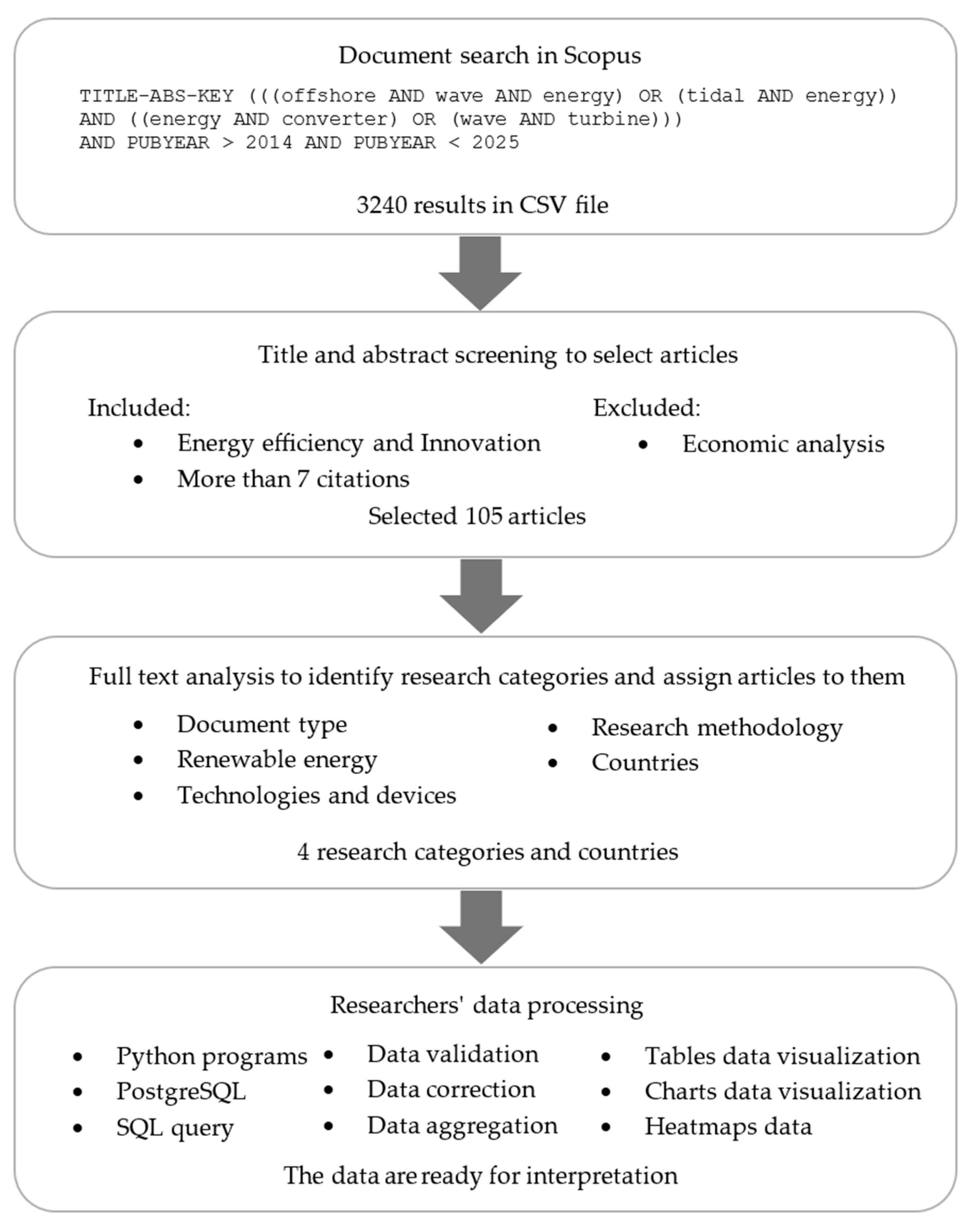
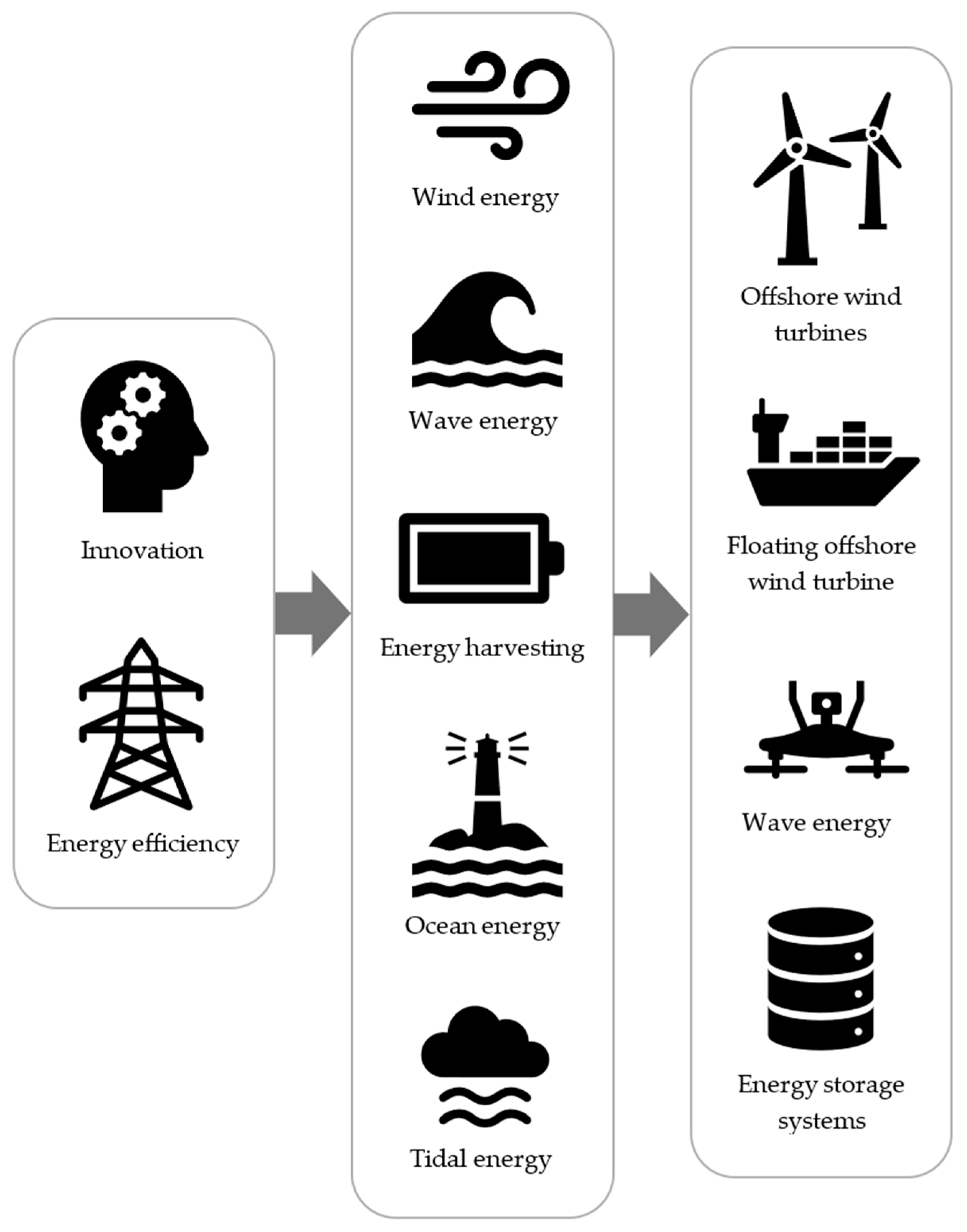
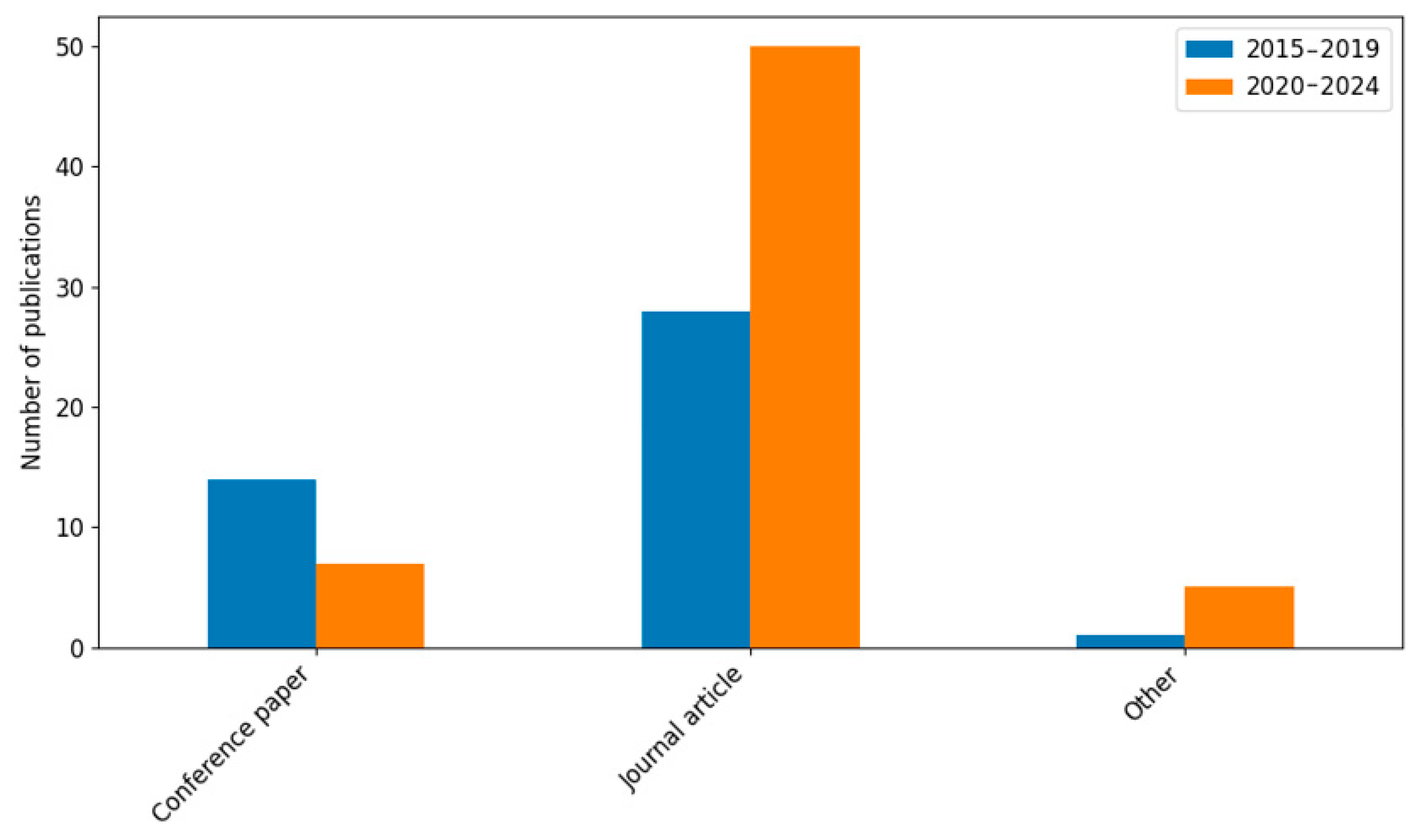
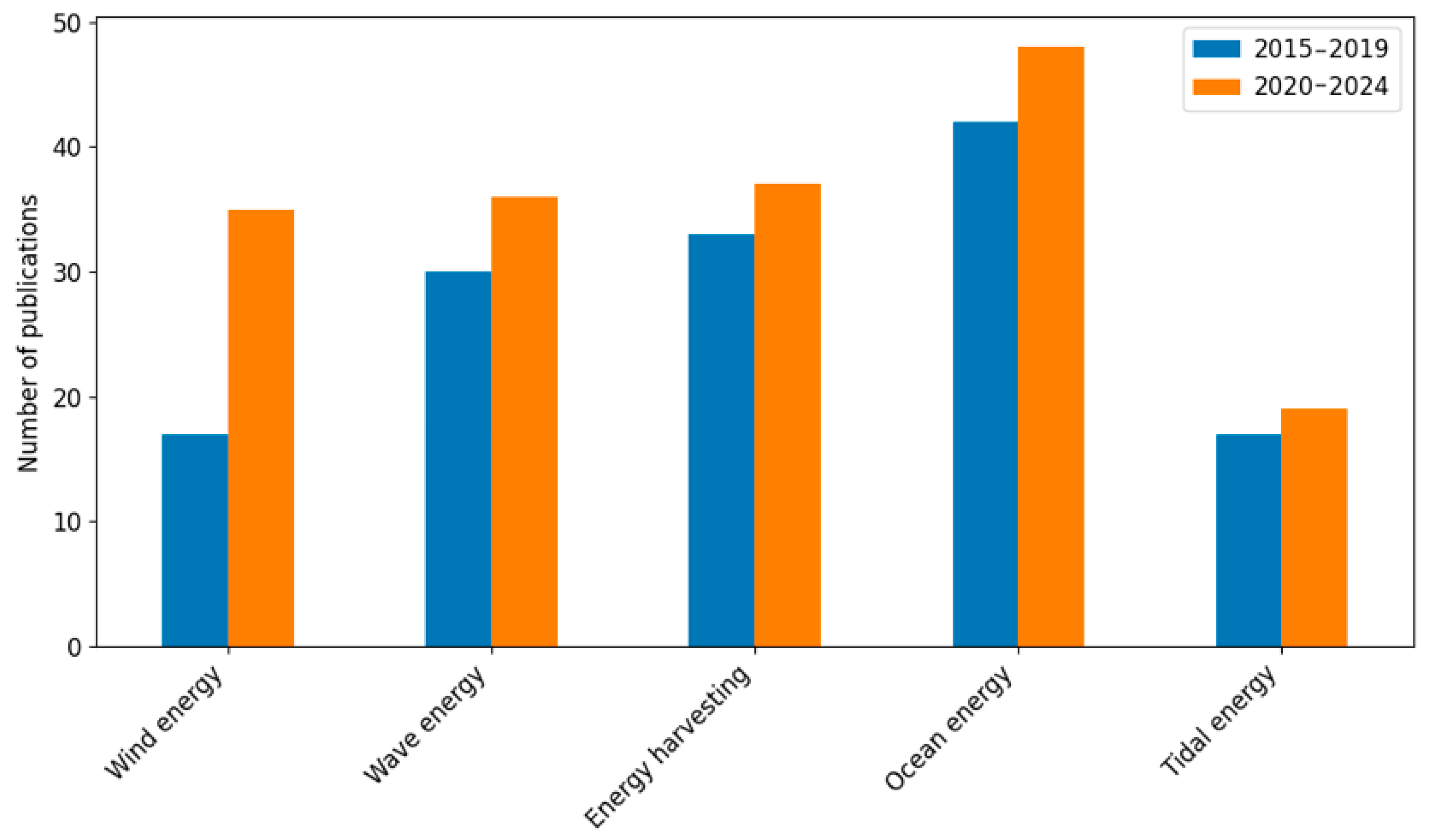

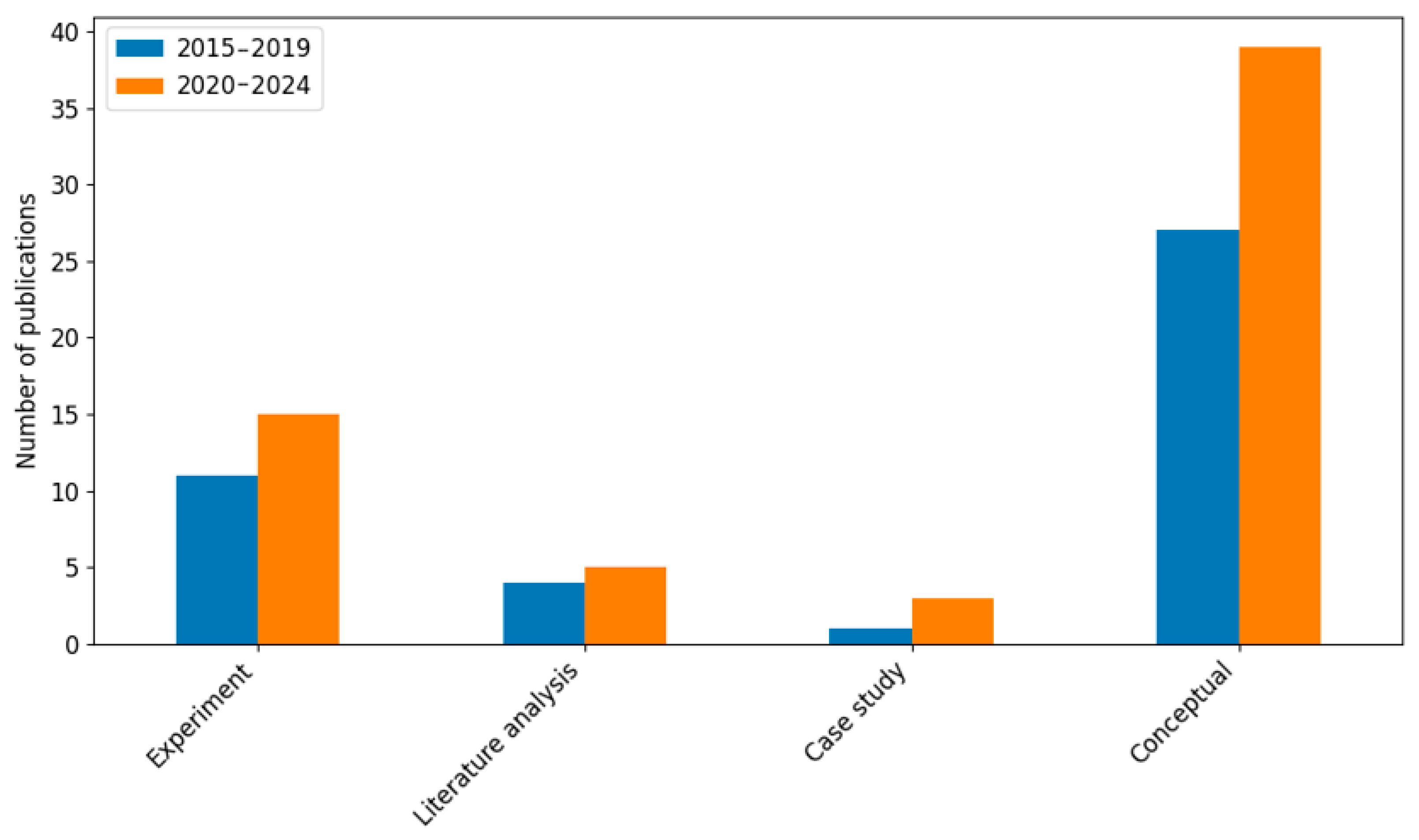
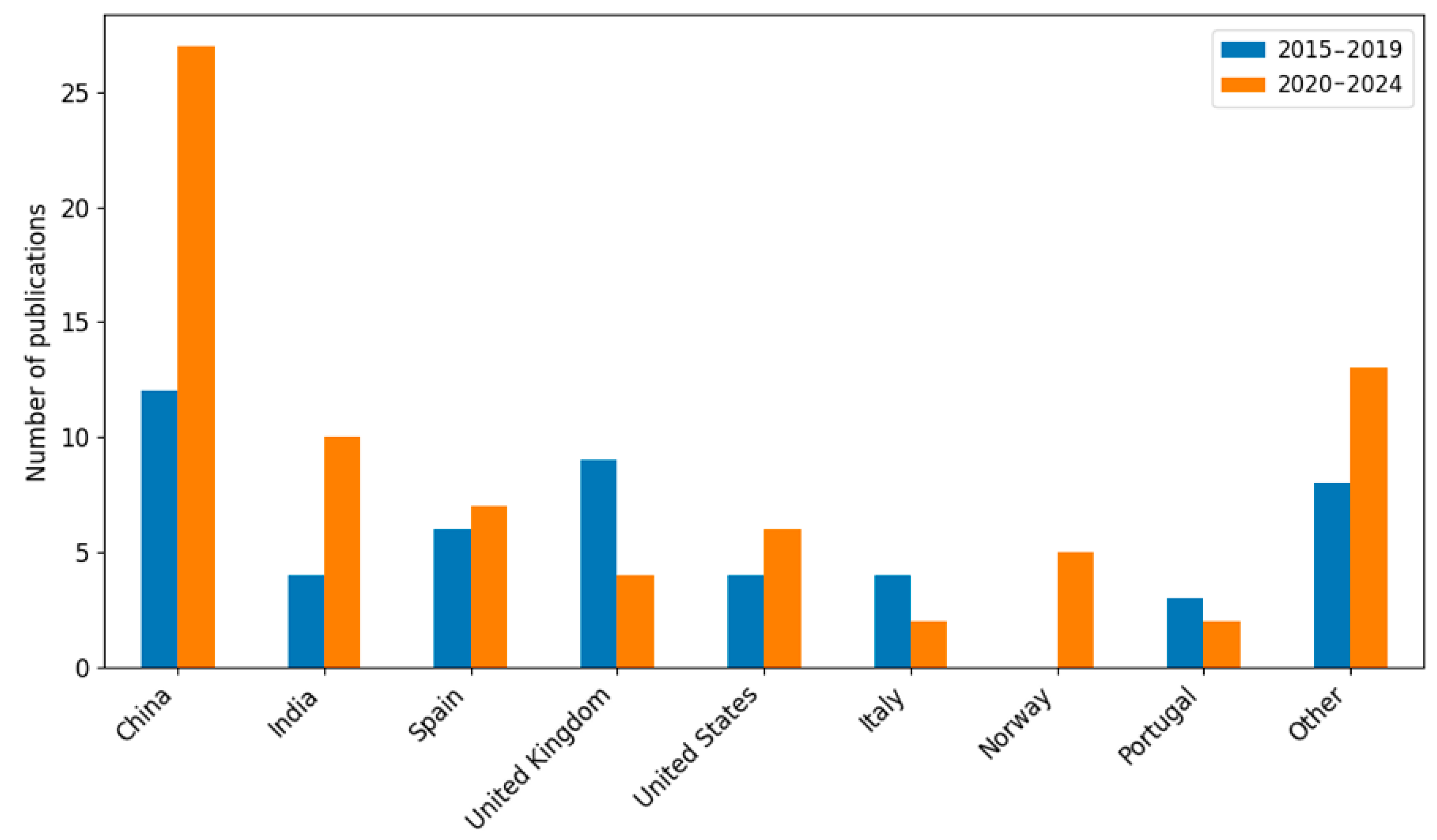
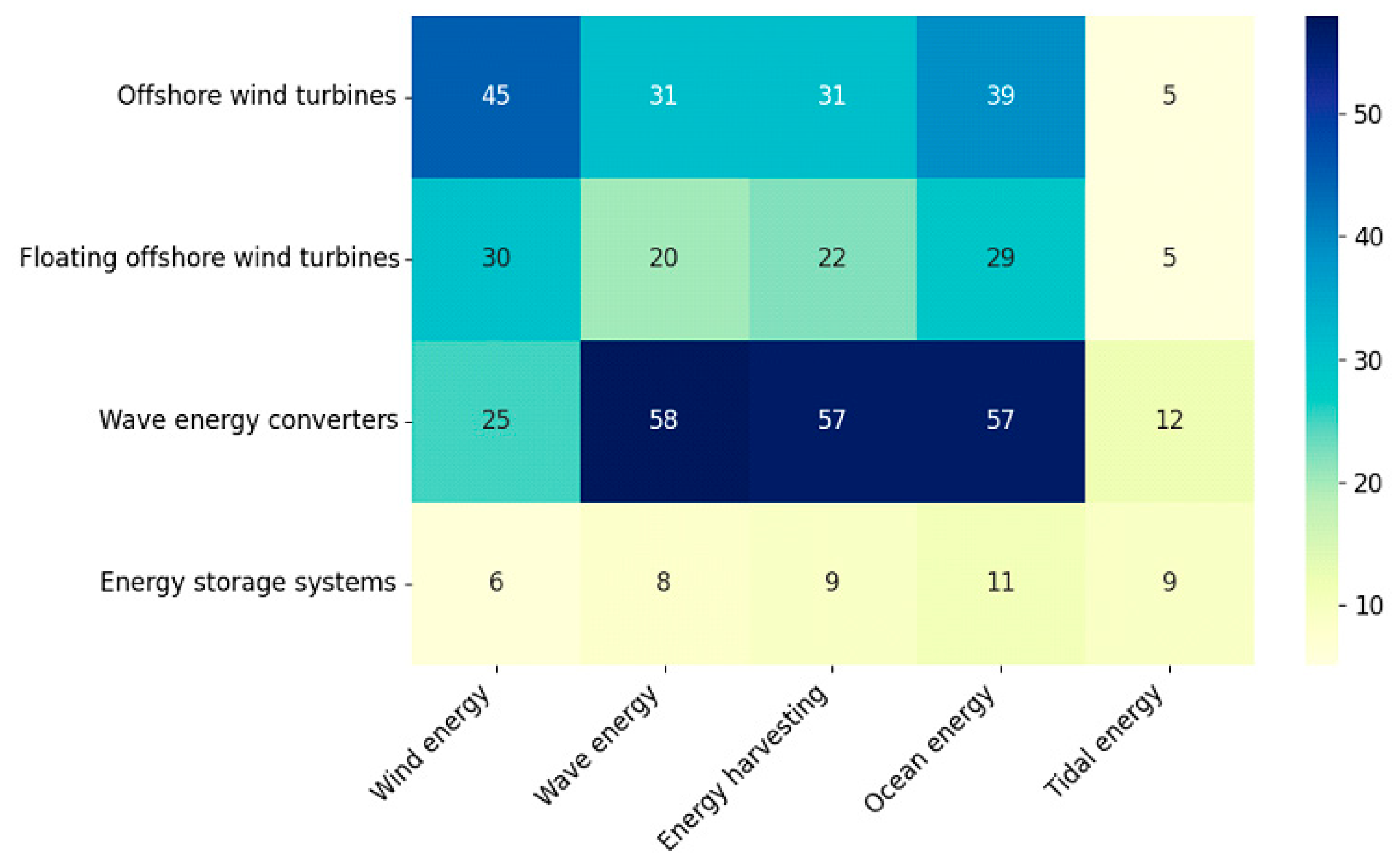
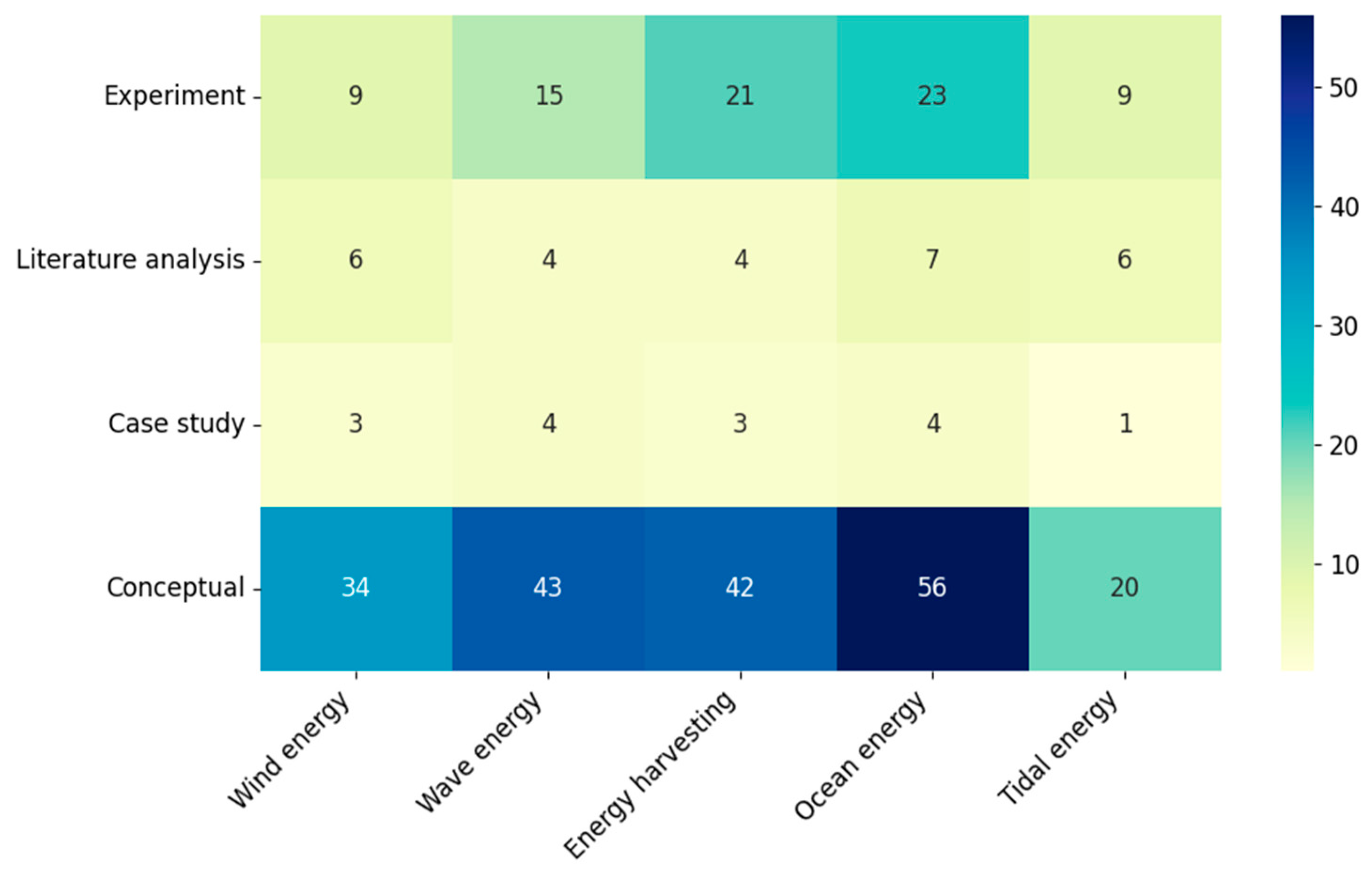
| Name | 2015–2019 | 2020–2024 | All Years | Share [%] | Chi-Square |
|---|---|---|---|---|---|
| Total | 43 | 62 | 105 | 100.0 | χ2 |
| Document type | |||||
| Conference paper | 14 | 7 | 21 | 20.0 | χ2 = 8.03 (df = 2, p = 0.02) |
| Journal article | 28 | 50 | 78 | 74.29 | |
| Other a | 1 | 5 | 6 | 5.71 | |
| Renewable energy b | |||||
| Wind energy | 17 | 35 | 52 | 49.52 | χ2 = 3.43 (df = 4, p = 0.49) |
| Wave energy | 30 | 36 | 66 | 62.86 | |
| Energy harvesting | 33 | 37 | 70 | 66.67 | |
| Ocean energy | 42 | 48 | 90 | 85.71 | |
| Tidal energy | 17 | 19 | 36 | 34.29 | |
| Technologies and devices b | |||||
| Offshore wind turbines | 15 | 30 | 45 | 42.86 | χ2 = 4.95 (df = 3, p = 0.18) |
| Floating offshore wind turbines | 9 | 24 | 33 | 31.43 | |
| Wave energy converters | 28 | 30 | 58 | 55.24 | |
| Energy storage systems | 5 | 11 | 16 | 15.24 | |
| Research methodology c | |||||
| Experiment | 11 | 15 | 26 | 24.76 | χ2 = 0.49 (df = 3, p = 0.92) |
| Literature analysis | 4 | 5 | 9 | 8.57 | |
| Case study | 1 | 3 | 4 | 3.81 | |
| Conceptual | 27 | 39 | 66 | 62.86 | |
| Country | 2015–2019 | 2020–2024 | All Years | Share [%] | Chi-Square |
|---|---|---|---|---|---|
| All countries | 43 | 62 | 105 | 100.0 | χ2 |
| China | 12 | 27 | 39 | 37.14 | χ2 = 12.99 (df = 8, p = 0.112) |
| India | 4 | 10 | 14 | 13.33 | |
| Spain | 6 | 7 | 13 | 12.38 | |
| United Kingdom | 9 | 4 | 13 | 12.38 | |
| United States | 4 | 6 | 10 | 9.52 | |
| Italy | 4 | 2 | 6 | 5.71 | |
| Norway | 0 | 5 | 5 | 4.76 | |
| Portugal | 3 | 2 | 5 | 4.76 | |
| Other | 8 | 13 | 21 | 20.00 |
| Name | Wind Energy | Wave Energy | Energy Harvesting | Ocean Energy | Tidal Energy | Total | Chi-Square |
|---|---|---|---|---|---|---|---|
| Total | 52 | 66 | 70 | 90 | 36 | 105 | χ2 |
| Technologies and devices | |||||||
| Offshore wind turbines | 45 | 31 | 31 | 39 | 5 | 45 | χ2 = 41.39 (df = 12, p = 4.22 ∗ 10−5) |
| Floating offshore wind turbine | 30 | 20 | 22 | 29 | 5 | 33 | |
| Wave energy converter | 25 | 58 | 57 | 57 | 12 | 58 | |
| Energy storage systems | 6 | 8 | 9 | 11 | 9 | 16 | |
| Research methodology | |||||||
| Experiment | 9 | 15 | 21 | 23 | 9 | 26 | χ2 = 7.76 (df = 12, p = 0.8) |
| Literature analysis | 6 | 4 | 4 | 7 | 6 | 9 | |
| Case study | 3 | 4 | 3 | 4 | 1 | 4 | |
| Conceptual | 34 | 43 | 42 | 56 | 20 | 66 | |
Disclaimer/Publisher’s Note: The statements, opinions and data contained in all publications are solely those of the individual author(s) and contributor(s) and not of MDPI and/or the editor(s). MDPI and/or the editor(s) disclaim responsibility for any injury to people or property resulting from any ideas, methods, instructions or products referred to in the content. |
© 2025 by the authors. Licensee MDPI, Basel, Switzerland. This article is an open access article distributed under the terms and conditions of the Creative Commons Attribution (CC BY) license (https://creativecommons.org/licenses/by/4.0/).
Share and Cite
Wilk-Jakubowski, J.L.; Pawlik, L.; Wilk-Jakubowski, G.; Harabin, R. State-of-the-Art in the Use of Renewable Energy Sources on the Example of Wind, Wave Energy, Tidal Energy, and Energy Harvesting: A Review from 2015 to 2024. Energies 2025, 18, 1356. https://doi.org/10.3390/en18061356
Wilk-Jakubowski JL, Pawlik L, Wilk-Jakubowski G, Harabin R. State-of-the-Art in the Use of Renewable Energy Sources on the Example of Wind, Wave Energy, Tidal Energy, and Energy Harvesting: A Review from 2015 to 2024. Energies. 2025; 18(6):1356. https://doi.org/10.3390/en18061356
Chicago/Turabian StyleWilk-Jakubowski, Jacek Lukasz, Lukasz Pawlik, Grzegorz Wilk-Jakubowski, and Radoslaw Harabin. 2025. "State-of-the-Art in the Use of Renewable Energy Sources on the Example of Wind, Wave Energy, Tidal Energy, and Energy Harvesting: A Review from 2015 to 2024" Energies 18, no. 6: 1356. https://doi.org/10.3390/en18061356
APA StyleWilk-Jakubowski, J. L., Pawlik, L., Wilk-Jakubowski, G., & Harabin, R. (2025). State-of-the-Art in the Use of Renewable Energy Sources on the Example of Wind, Wave Energy, Tidal Energy, and Energy Harvesting: A Review from 2015 to 2024. Energies, 18(6), 1356. https://doi.org/10.3390/en18061356







